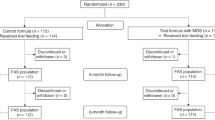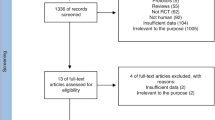Abstract
The breast-fed infant is the gold standard for infant formula research and development. The addition of long-chain polyunsaturated fatty acids and nucleotides to formula are intended to promote visual, neuro and immune development. Studies in both preterm and term infants have not consistently demonstrated efficacy with long-chain polyunsaturated fatty acids supplementation of infant formulas. Explanations for why these supplemented formulas do not always produce visual or neurodevelopmental advantages, include a small individual effect or that only a proportion of infants will benefit or the presence of confounding variables. The efficacy of nucleotides has been studied by analyzing response to vaccination in infants fed human milk versus formulas with or without additional nucleotides. Nucleotide supplemented formulas appear to enhance immune response similar to breast-fed infants with immunization. Humanizing formula with safe and well-studied nutrients may provide benefits that are discovered long after initial trials are concluded.
This is a preview of subscription content, access via your institution
Access options
Subscribe to this journal
Receive 12 print issues and online access
$259.00 per year
only $21.58 per issue
Buy this article
- Purchase on Springer Link
- Instant access to full article PDF
Prices may be subject to local taxes which are calculated during checkout
Similar content being viewed by others
References
Clandinin MT, Chappell JE, Heim T, Swyer PR, Chance GW . Fatty acid utilization in perinatal de novo synthesis of tissues. Early Hum Dev 1981; 5: 355–366.
Ponder DL, Innis SM, Benson JD, Siegman JS . Docosahexaenoic acid status of term infants fed breast milk or infant formula containing soy oil or corn oil. Pediatr Res 1992; 32: 683–688.
Gibson RA, Chen W, Makrides M . Randomized trials with polyunsaturated fatty acid interventions in preterm and term infants: functional and clinical outcomes. Lipids 2001; 36: 873–883.
Uauy R, Hoffman DR, Mena P, Llanos A, Birch E . Term infant studies of DHA and ARA supplementation on neurodevelopment: results of randomized controlled trials. J Pediatr 2003; 143: S17–25.
Makrides M, Neumann MA, Gibson RA . Is dietary docosahexaenoic acid essential for term infants? Lipids 1996; 31: 115–119.
Carlson SE, Ford AJ, Werkman SH, Peeples JM, Koo WW . Visual acuity and fatty acid status of term infants fed human milk and formulas with and without docosahexaenoic and arachidonate from egg yolk lecithin. Pediatr Res 1996; 39: 882–888.
Horby JM, Holmer G, Lund P, Hernell O, Michaelsen KF . Effect of formula supplementation with docosahexaenoic acid and gamma-linolenic acid on fatty acid status and visual acuity in term infants. J Pediatr Gastroenterol Nutr 1998; 26: 412–421.
Birch EE, Hoffman DR, Uauy R, Birch DG, Prestidge C . Visual acuity and the essentiality of docosahexaenoic acid and arachidonic acid in the diet of term infants. Pediatr Res 1998; 44: 201–209.
Auestad N, Montalto MB, Hall RT, Fitzgerald KM, Wheeler RE, Connor WE et al. Visual acuity, erythrocyte fatty acid composition, and growth in term infants fed formulas with long chain polyunsaturated fatty acids for one year: Ross Pediatric Lipid Study. Pediatr Res 1997; 41: 1–10.
Scott DT, Janowsky JS, Carroll RE, Taylor JA, Austead N, Montalto MB . Formula supplementation with long-chain polyunsaturated fatty acids: are there developmental benefits? Pediatrics 1998; 102: E59.
Lucas A, Stafford M, Morley R, Abbott R, Stephenson T, MacFadyen U et al. Efficacy and safety of long-chain polyunsaturated fatty acid supplementation of infant-formula milk: a randomized trial. Lancet 1999; 354: 1948–1954.
Auestad N, Halter R, Hall RT, Blatter M, Bogle ML, Burks W et al. Growth and development in term infants fed long-chain polyunsaturated fatty acids: a double-masked, randomized, parallel, prospective, multivariate study. Pediatrics 2001; 108: 372–381.
Makrides M, Neumann MA, Simmer K, Gibson RA . A critical appraisal of the role of dietary long-chain polyunsaturated fatty acids on neural indices of term infants: a randomized, controlled trial. Pediatrics 2000; 105: 32–38.
Carlson SE, Werkman SH, Rhodes PG, Tolley EA . Visual acuity development in healthy preterm infants: effect of marine oil supplementation. Am J Clin Nutri 1993; 58: 35–42.
Carlson SE, Werkman SH . A randomized trial of visual attention of preterm infants fed DHA until 2 months. Lipids 1996; 31: 91–97.
Hansen J, Schade D, Harris C, Merkel K, Adamkin D, Hall R et al. Docosahexaenoic acid plus arachidonic acid enhance preterm infant growth. Prostaglandins Leukot Essent Fatty Acids 1997; 57: 196.
Birch DG, Birch EE, Hoffman DR, Uauy RD . Retinal development of very low birthweight infants fed diets differing in n-3 fatty acids. Invest Ophthalmol Vis Sci 1992; 33: 2365–2376.
Innis SM, Adamkin DH, Hall RT, Kalhan SC, Lair C, Lim M et al. Docosahexanoic acid and arachidonic acid enhance growth with no adverse effects in preterm infants fed formula. J Pediatr 2002; 140: 547–554.
O'Connor DL, Hall R, Adamkin DH, Austead N, Castillo M, Connor WE et al. Growth and development in preterm infants fed longchain polyunsaturated fatty acids: a prospective randomized trial. Pediatrics Aug 2001; 108: 359–371.
Fewtrell MS, Morley R, Abbott Ra, Singhal A, Isaacs EB, Stephensen T et al. Double-blind randomized trial of long-chain polyunsaturated fatty acids in formula fed to preterm infants. Pediatrics 2002; 110: 73–82.
van Wezel-Meijler G, van der Knaap MS, Hulsman J, Jonkman EJ, Valk J, Lafeber HN . Dietary supplementation of long-chain polyunsaturated fatty acids in preterm infants: effects on cerebral maturation. Acta Paediatr 2002; 91: 942–950.
Carlson SE, Cooke RJ, Werkman SH, Rhodes PG, Tolley EA . First year growth of preterm infants fed standard compared to marine oil n-3 supplemented formula. Lipids 1992; 27: 901–907.
Carlson SE, Werkman SH, Tolley EA . Effect of long-chain n-3 fatty acid supplementation on visual acuity and growth of preterm infants with and without bronchopulmonary dysplasia. Am J Clin Nutr 1996; 63: 687–697.
Faldella G, Govoni M, Alessandroni R, Marchiani E, Salvioli GP, Biagi PL et al. Visual evoked potentials and dietary long-chain polyunsaturated fatty acids in preterm infants. Arch Dis Child Fetal Neonatal 1996; 75: F108–F112.
Clandinin MT, Van Aerde JE, Parrott A, Field CJ, Euler AR, Lien EL . Assessment of the efficacious dose of arachidonic and docosahexanoic acids in preterm infant formulas: Fatty acid composition of erythrocyte membrane lipids. Pediatr Res 1997; 42: 819–825.
Vanderhoof J, Gross S, Hegyi T, Clandinin T, Porcelli P, DeCristofaro J et al. Evaluation of a long-chain polyunsaturated fatty acid supplemented formula on growth, tolerance, and plasma lipids in preterm infants up to 48 weeks postconceptual age. J Pediatr Gastroenterol Nutr 1999; 29: 318–326.
Gibson RA, Neumann MA, Makrides M . Effect of increasing breast milk docosahexanoic acid on plasma and erythrocyte phospholipids fatty acids and neural indices of exclusively breast fed infants. Eur J Clin Nutr 1997; 51: 578–584.
Clandinin MT, VanAerde J, Merkel K, Harris C, Springer M, Hansen J et al. Growth and development of preterm infants fed formulas containing docosahexanoic acid and arachidonic acid. J Pediatr 2005; 146: 461–468.
Groh-Wargo S, Jacobs J, Austead N, O'Connor D, Moore J, Lerner E . Body composition in preterm infants who are fed long-chain polyunsaturated fatty acids: a prospective randomized controlled trial. Pediatr Res 2005; 57: 712–718.
Carver JD . Dietary nucleotides: effects on the immune and gastrointestinal systems. Acta Paediatr 1999; 430: 83–88.
Aggett P, Leach JL, Rueda R, MacLean Jr WC . Innovation in formula development: a reassessment of ribonucleotides in 2002. Nutrition 2003; 19: 375–384.
Brunser O, Espinoza J, Araya M, Cruchet S, Gil A . Nucleotide supplementation on diarrheal disease in infants. Acta Paediatr 1994; 83: 188–191.
Pickering LK, Granoff DM, Erickson JR, Masor ML, Cordle CT, Schaller JP et al. Modulation of the immune system by human milk and infant formula containing nucleotides. Pediatrics 1998; 101: 242–249.
Yau KI, Haung CB, Chen W, Chen SJ, Chou YH, Haung FY et al. Effect of nucleotides on diarrhea and immune responses in healthy term infants in Taiwan. J Pediatr Gastroenterol Nutr 2003; 36: 37–43.
Schaller JP, Kuchan MJ, Thomas DL, Cordle CT, Winship TR, Buck RH et al. Effect of dietary ribonucleotides on infant immune status. Part1: humoral responses. Pediatr Res 2004; 56: 883–890.
Hawkes JS, Gibson RA, Roberton D, Markrides M . Effect of dietary supplementation on growth and immune function in term infants: a randomized controlled trial. Eur J Clin Nutr 2006; 60: 254–264.
Carver JD, Pimentel B, Cox WI, Barness LA . Dietary nucleotides effects upon immune function in infants. Pediatrics 1991; 88: 359–363.
Buck RH, Thomas DL, Winship TR, Cordle CT, Kuchean MJ, Baggs GE et al. Effect of dietary ribonucleotides on infant immune status. Part 2: immune cell development. Pediatr Res 2004; 56: 891–900.
Simmer K, Patole S . Longchain polyunsaturated fatty acid supplementation in preterm infants. Cochrane Database Syst Rev 2004; 1: DOI:10.1002/14651858.CD000375.pub2.
Wharton BA, Morley R, Isaacs EB, Cole TJ, Lucas A . Low plasma taurine and later neurodevelopment. Arch Dis Child Fetal Neonatal Ed 2004; 89: F497–F498.
Forsyth JS, Willats P, Agostoni C, Bissenden J, Caseer P, Boeh MG . Long chain polyunsaturated fatty acid supplementation in infant formula and blood pressure in later childhood: follow up of a randomized control trial. BMJ 2003; 326: 953.
Mori TA, Bao DQ, Burke V, Puddley IB, Beilin LJ . Docosoahexaenoic acid but not eicosapentaenoic acid lowers ambulatory blood pressure and heart rate in humans. Hypertension 1999; 34: 253–260.
Author information
Authors and Affiliations
Corresponding author
Rights and permissions
About this article
Cite this article
Adamkin, D. Controversies in neonatal nutrition: docosahexanoic acid (DHA) and nucleotides. J Perinatol 27 (Suppl 1), S79–S82 (2007). https://doi.org/10.1038/sj.jp.7211711
Published:
Issue Date:
DOI: https://doi.org/10.1038/sj.jp.7211711



